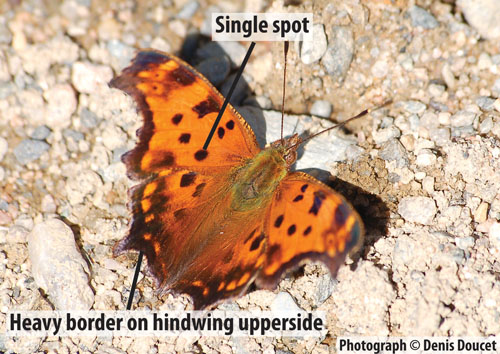Eastern Comma (Polygonia comma)
Description: Very similar to the other comma species, Eastern Comma is most similar to Satyr Comma. It differs from this species slightly in upperside color, usually more orange with reddish-brown markings in Eastern Comma and tawny with dark brown markings in Satyr Comma. The hindwing is more heavily marked in Eastern Comma while Satyr Comma has just a narrow brown margin. The underside pattern appears more mottled in Eastern Comma while it is more striated in Satyr Comma. Female Eastern Comma is very similar to Green Comma, it is distinguished its more regular wing margin (wing margin very ragged in Green Comma) and the absence of green spots along the wing margins. There are two forms of Eastern Comma. In the summer form the hindwings are nearly black above. Wingspan: 37 to 56 mm.
Maritime Distribution: Southern New Brunswick and Nova Scotia. For Atlas results click here.
Provincial Ranks: NB: S4. NS: S1?. PEI: SNR.
Flight Period: April to October. There are two generations per year, the first emerging in mid June, and the second (the individuals that overwinter) emerging in August.
Host Plant: Stinging Nettle (Urtica dioica), Wood Nettle (Laportea canadensis), elm (Ulmus spp.) and Hops (Humulus lupulus).
Notes: In the Maritimes this species may be found in parks, suburbs, and a variety of forest habitats. Though generally rare in the Maritimes, it is common in the floodplains of the Saint John River where nettles grow in profusion.
All commas can be difficult to identify, and being able to do so with confidence requires experience. This is particularly true with spring specimens that are quite worn.


